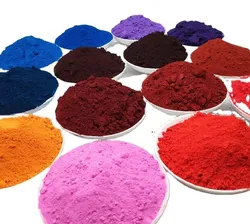What Are Inorganic Pigments and Why Are They Important in Modern Industry?
2024-12-23
Inorganic pigments are some of the most widely used colorants across various industries, from paints and coatings to plastics, ceramics, and even food products. Unlike organic pigments, which are carbon-based, inorganic pigments are typically derived from mineral sources and metals. But what exactly are inorganic pigments, and why are they so important in modern industry? In this blog, we’ll explore the fundamental characteristics of inorganic pigments, their applications, and their significance across different sectors.
1. What Are Inorganic Pigments?
Inorganic pigments are colorants made from non-carbon-based materials, including minerals, metals, and metal oxides. These pigments are usually composed of inorganic compounds like iron oxide, titanium dioxide, chromium oxide, and ultramarine blue, to name a few. They are often more stable than organic pigments, which makes them suitable for a variety of applications where long-lasting color is needed.
- Stability and Durability: Inorganic pigments are known for their superior resistance to heat, light, and chemicals. This makes them ideal for applications in outdoor settings, industrial environments, and other challenging conditions.
- Opacity: Many inorganic pigments have excellent opacity, meaning they can cover surfaces effectively and provide vibrant colors without needing multiple coats.
2. How Do Inorganic Pigments Differ from Organic Pigments?
While both inorganic and organic pigments are used to create color in various materials, there are some key differences between the two:
- Composition: Organic pigments are carbon-based and are often derived from petroleum products or natural sources like plants. In contrast, inorganic pigments are derived from mineral and metallic sources.
- Color Range: Organic pigments typically offer a broader range of vivid and vibrant colors. Inorganic pigments, on the other hand, tend to offer earthier, more muted tones, although they can be just as vibrant depending on the compound.
- Durability: Inorganic pigments are generally more stable and long-lasting than their organic counterparts. They are less susceptible to fading or chemical breakdown, making them ideal for long-term applications.
- Toxicity: Inorganic pigments can sometimes be toxic, particularly those containing heavy metals like cadmium or chromium. However, modern advancements in pigment technology have led to the development of non-toxic alternatives.
3. What Are the Key Applications of Inorganic Pigments?
Inorganic pigments are incredibly versatile and are used in a wide range of applications. Let’s take a closer look at some of the most common industries that rely on these pigments:
- Paints and Coatings: Inorganic pigments are widely used in paints and coatings because of their durability and color stability. They are especially valued for their resistance to fading and weathering, which makes them perfect for use in exterior paints, industrial coatings, and automotive finishes.
- Plastics and Rubber: These pigments are added to plastics and rubber to provide color while maintaining the material’s strength and flexibility. Inorganic pigments are particularly useful in the production of colored plastics used in household goods, toys, and automotive parts.
- Ceramics and Glass: In the ceramics industry, inorganic pigments are used to color glazes and pottery. These pigments also find applications in glassmaking, where they help create tinted glass products such as windows and bottles.
- Cosmetics and Personal Care Products: Certain inorganic pigments, such as titanium dioxide and iron oxide, are used in cosmetics, including foundations, blushes, and eyeshadows. They provide natural-looking colors and act as sunscreens in products like tinted moisturizers.
- Food and Pharmaceuticals: Some inorganic pigments, like titanium dioxide, are also used as food colorants and in pharmaceutical products. However, their use in food is regulated by government bodies to ensure safety.
4. Why Are Inorganic Pigments Essential in the Automotive Industry?
The automotive industry heavily relies on inorganic pigments, particularly for automotive coatings. These pigments provide excellent color retention and resistance to harsh weather conditions, making them an essential component for producing durable and long-lasting vehicle finishes. For example, titanium dioxide is often used in car paints for its high opacity and whiteness, while iron oxide is used to create deep red and brown tones.
- Weather Resistance: Inorganic pigments are known for their exceptional ability to withstand UV rays, which helps prevent fading in automotive paints over time.
- Scratch Resistance: These pigments also provide scratch-resistant properties, ensuring that the vehicle’s color remains intact even after years of use.
5. What Are the Environmental Impacts of Inorganic Pigments?
While inorganic pigments are known for their durability, they can also pose environmental concerns, particularly those containing heavy metals like cadmium, lead, and chromium. However, regulatory frameworks have been established to control the use of toxic materials in pigments, and many modern inorganic pigments are now made without these harmful substances.
- Eco-Friendly Alternatives: Advances in pigment technology have led to the development of safer, more eco-friendly inorganic pigments. These alternatives reduce the environmental impact of pigment production while maintaining the performance benefits of traditional pigments.
- Recyclability: Many inorganic pigments are stable and do not break down easily, meaning that products made with these pigments are often more recyclable than those made with organic alternatives.
Conclusion
Inorganic pigments play a crucial role in modern industry due to their stability, durability, and wide range of applications. From automotive paints and coatings to ceramics and food products, these pigments provide long-lasting color while offering the necessary performance characteristics for various industries. As technological advancements continue, the production of environmentally friendly and non-toxic inorganic pigments will only increase, making them even more essential in the years to come.



